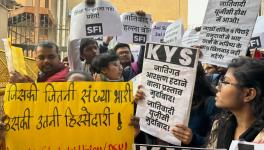Women as Flag-Bearers in Representational Democracy
Representational use only.Image Courtesy: The Leaflet
The Constitution (128th Amendment) Bill, 2023, has passed in both Houses of Parliament, and 33% reservation for women in the Lok Sabha and State legislatures will be a reality one day. The objectives of this Bill align with the Sustainable Development Goals of the United Nations, which says countries must achieve gender equality and empower women and girls. However, the future of this goal in India is uncertain, and administrative roadblocks lie ahead.
The 2023 law is being projected as a key pedestal for India to emancipate women. Indeed, the Bill passed with a record majority in Parliament. Now, it will be tested on whether it ends the decades of gender blockade, considering the unanimity across party lines. The reform through Article 15(3)—special provisions for women—has friction points that must be addressed before patriarchal society meets its slow eclipse.
Old Wine, New Bottle
The last attempt to enact a law reserving seats for women in Parliament was in 2010 in the Rajya Sabha, but that Bill could not be passed in the Lok Sabha. Political parties have also demanded a ‘quota within quota’, that is, horizontal reservations within the 33% seats reserved for women, so that the beneficiaries of affirmative action—the Scheduled Castes, Scheduled Tribes and Other Backward Classes—also gain representation among women candidates that parties field once the reservation for women comes into effect.
In 2022, the Supreme Court ruled in Saurav Yadav vs State of Uttar Pradesh that any changes [such as horizontal reservations] within prescribed seats will affect “merit” and complicate interlocking reservations. Moreover, the differently abled, the dependents of freedom fighters, ex-servicemen and other categories can also constitute layers of affirmative action that might muddy the waters.
Given the jurisprudence on reservations, the government does not want any horizontal reservations within reservations for women, for it could invite legal and constitutional challenges.
Census and Delimitation
The President’s assent would make the Women’s Reservation Bill law, but the real elephant in the room is the next Census and subsequent delimitation of constituencies based on its findings. The last decadal Census was released in 2011, and all policy planning has relied on that data. The 2021 Census was postponed because of the pandemic and Assembly elections.
Further, an amendment to Article 82 of the Constitution in 2001 by the Atal Bihari Vajpayee government had frozen the number of constituencies until 2026. The Union Law Ministry has used this limitation to prevent the Women’s Reservation Bill from coming into force in the 2024 Lok Sabha election.
So, when will the promises in this Bill come into force?
As per Article 82, the Delimitation Act is passed after every Census. After this exercise, the central government constitutes a Delimitation Commission to analyse the new population matrix and reallocate seats based on percentages for each State.
The last Delimitation Commission was constituted in 2002 and tabled its report in Parliament after six long years. Assuming the next Census is carried out after the 2024 Lok Sabha election, and notified around 2026, we will not see women’s reservations come into effect until 2039. This remains the case even if the next Census is conducted and published in 2031 unless each element of the process is fast-tracked.
A similar delimitation happened in 2021 as part of the Fifteenth Finance Commission processes. The terms of reference of the commission mentioned that the year from which taxes would be demarcated from the central pool (so far, it had been the 1971 Census) would change to the 2011 Census. This thirty-year gap fiscally penalised the southern states. This is because between 1971 and 2011, the population growth rate in the southern states had been on a faster trajectory of decline compared with the northern states. The souther states had successfully implemented the Centre’s family-planning initiatives, while the northern states had lagged behind.
While the reservation for women is linked to the Census and eventual delimitation, the architecture of the Goods and Services Tax (GST) is based on the population of a State and not its size. For example, Goa might generate considerable indirect tax revenues due to tourism but has a smaller settled population compared with Bihar, whose population is higher but produces lower indirect tax revenues. Because the growth-parity mechanism is embedded in the terms of reference of the Finance Commission, the GST revenues collected by the Centre, which are redistributed among the States, makes the smaller but better-off states foot the bill for the larger and more populous states.
This might seem like a benevolent gesture by the better-off states in the name of fiscal federalism to ensure overall progress of the nation. Yet, it is undeniable that overarching central policies need to consider the needs of the better-off states which have implemented central projects and plans more effectively. The Centre and states need to foster policies that promote industrialisation and employment opportunities in the less well-off states to reduce the burden on states that have performed better.
Scapegoat Tickets?
Legislated gender quotas can help achieve political equality, but history shows the opposite is equally true in India. Women candidates are fielded as proxies for male representatives. But for the earmarked mandatory reservations, most women would not get to contest at all. This has been the case in the reservations for the Scheduled Caste and Scheduled Tribes, which alone has ensured their representation in the Lok Sabha and State assemblies.
Clause (3) of Article 243D of the Constitution mandates the participation of women in Panchayati Raj Institutions by mandating not less than one-third reservation for women on seats filled through direct elections, and in the Panchayat chairperson seats.
At least 20 states have made over 50% reservation provisions for women through their respective State Panchayati Raj Acts. But the sarpanch woman is still a facade for male behind-the-scenes contestants, often a husband, brother or in-law who attends to official tasks. Meanwhile, the elected woman sarpanch signs on documents without having an active role in day-to-day affairs. Worse, she pays the price for any wrongdoings committed by her male relatives in the course of this arrangement. If he has pending criminal cases, shifts party affiliation or seeks temporary retirement, the wife steps in, but only to fill the vacuum.
Interestingly, women are asserting their voting rights in large numbers across the country, as seen in the latest State elections in Uttarakhand, Goa, Manipur, Uttar Pradesh and Punjab, where the turnout of women surpassed men. This means women constitute a sizeable vote bank that merits being taken seriously. However, there is a chasm between the number of women voters and those elected in the same electoral process.
Political parties led by women also have barely any women representatives. In Tamil Nadu, late AIADMK supremo J Jayalalithaa ensured 31 women MLAs when she formed the government in 1991. That has come down to 12 in an Assembly comprising 234 MLAs. Mamata Banerjee’s West Bengal Assembly has 41 women MLAs in a 291-member house.
In the largest State, Uttar Pradesh, Mayawati’s Bahujan Samaj Party has only one male MLA in the current Assembly, whereas she fielded 21 women candidates in 2017 in an Assembly of 403 seats. It is an emancipatory party representing the interests of the Dalit communities, but the BSP does not have a woman in its national executive or among its Members of Parliament, coordinators, or district presidents. Unlike other parties, the BSP does not have a women’s wing either.
The Lok Sabha has 78 women Members of Parliament out of its 543 total members, and the Rajya Sabha has 24 female members out of 224. The numbers speak for themselves, that there will be no substantive change without greater intra-party representation for women.
Why not Fifty Percent?
The standard reasons for limiting reservations for women at 33% are that people trust men more when it comes to governance and that women should get more opportunities to rise through the ranks before space is ‘allocated’ for them. These excuses demonstrate the alarming reality of how underprepared India is for including women at all levels.
In 2021, speaking at an event organised by the women advocates of the Supreme Court, former Chief Justice NV Ramana supported 50% reservation for women in all levels of the judiciary. He cited India’s 6,000 courts, in which 22% do not have separate toilets for women and lack other infrastructure, leading to crowded courtrooms where creches and even sitting places are absent.
Nevertheless earlier this year, the Supreme Court refused 50% reservation for women in the National Defence Academy, calling it the prerogative of the Armed Forces, though it urged the government to ensure parity in recruitment within the national security framework.
In this context, the Women’s Reservation Bill strives to achieve equality for women in State and central elected roles. However, this vision would remain a distant dream until women are empowered to take up such opportunities. Until then, most women representatives would be facades behind whom men would dominate.
The authors are assistant professors at St Joseph’s College of Law, Bangalore. The views are personal.
Get the latest reports & analysis with people's perspective on Protests, movements & deep analytical videos, discussions of the current affairs in your Telegram app. Subscribe to NewsClick's Telegram channel & get Real-Time updates on stories, as they get published on our website.
























